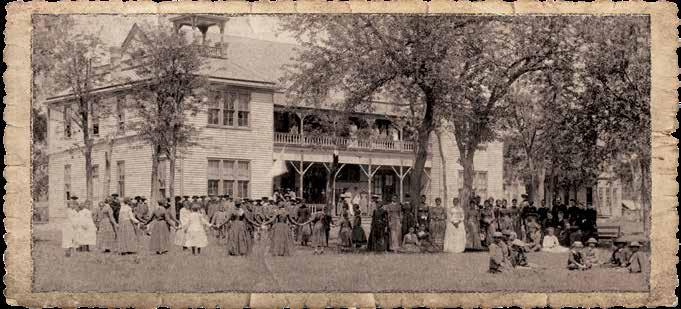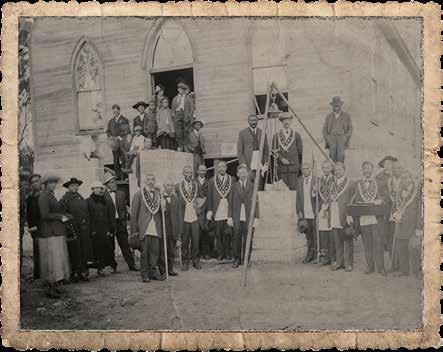




This screening guide is designed to accompany Black Frontier Towns, an award-winning OETA original series produced by the Oklahoma News Report. The series explores the founding, history, challenges, and resilience of Oklahoma’s historic Black towns— unique communities born from the dreams of freedom, self-governance, and land ownership.
This guide offers tools and prompts to encourage discussion, reflection, and community engagement for libraries, educators, and civic organizations hosting screenings of the series.
Use this guide to:
• Facilitate conversations before and after screenings
• Encourage historical reflection and civic dialogue
• Inspire connections between past and present efforts to sustain Black towns



Both the Dawes Act of 1887 and the Curtis Act of 1898 significantly disempowered Native Americans in Oklahoma. These legislative measures undermined tribal sovereignty through the dissolution of treaties and drastically reduced Native land ownership, stripping Indigenous communities of over 125,000 acres of their ancestral lands for government infrastructure projects and construction. White settlers, Freedmen and other formerly enslaved Black people would acquire these allotted lands, leading to the development of Black towns.
The Oklahoma Territory was made available to farmers, settlers, and freed slaves as a part of the next frontier in American expansion inspired by the Homestead Act of 1862. Despite its uncertain terrain and diverse climate, many newly freed slaves looked to the Oklahoma Territory as the launch pad for them to realize their own dreams of freedom in America. Sparked by Edward P. McCabe, the movement to make Oklahoma an all-Black state produced more than 50 Black towns. This range of enclaves envisioned, developed, and governed solely by Black people was unlike anywhere else in America at the time or since.

Today, those who remain in the historic Black towns celebrate the rich history while also imagining a renewed future that includes a vibrant economic and community-centered life. Towns like Boley continue to captivate audiences from across the country with its annual rodeo that also serves as an economic catalyst. Langston, home to Oklahoma’s only Historically Black College and University (HBCU) Langston University, is leveraging its unique history to strengthen the university relationship to modernize the town. Across the 13 stories highlighting Oklahoma’s Black towns, each community is working to rejuvenate its once vibrant and resilient heritage.
OETA’s Oklahoma News Report developed a yearlong series highlighting the remaining Black towns in Oklahoma. Each town profile includes insight into its founding and establishment, its unique traditions that have persisted today, and the challenges to rebuilding the social, economic, and physical infrastructure of these once-thriving towns. Through this series, OETA’s Oklahoma News Report sheds light on the enduring resilience of these communities, offering a deeper understanding of their historical significance and ongoing efforts toward revitalization.

This guide is designed to facilitate reflection, discussion, and engagement around Black Frontier Towns, a documentary series produced by OETA’s Oklahoma News Report. Drawing on the legacy of Oklahoma’s historic all-Black communities, this guide helps viewers explore themes of self-determination, displacement, cultural identity, and community sustainability.
Use the guide in whole or in part to support:
• Community or classroom screenings
• Civic dialogues and town halls
• Educational enrichment or curriculum enhancement
• Strategic planning in revitalization efforts
Whether audiences are deeply familiar or newly introduced to Oklahoma’s Black towns, this guide aims to support meaningful dialogue and broaden understanding.



Following the Civil War and the passage of the Dawes and Curtis Acts, newly freed African Americans sought refuge, safety, and sovereignty through the creation of all-Black towns in Oklahoma. More than 50 towns were established, offering a vision of freedom grounded in land ownership, self-governance, and Black excellence. Today, only a handful of these towns remain, each grappling with modern challenges while preserving their unique legacy.
Pose these questions before the screening to frame the conversation:
1. What do you know about Oklahoma’s history prior to statehood?
2. What does the idea of “freedom” mean when linked to land and self-governance?
3. Why do people migrate, and how do community values influence their journey?
• Be prepared. Reflect on your own reactions to the material before leading discussion.
• Stay neutral. Create space for varied experiences and voices.
• Pause often. Allow silence and time for thought. Let people process emotionally charged material.
• Embrace complexity. Encourage multiple perspectives, especially when discussing race, history, and power.

1. Freedom as Foundation
Discussion Prompts:
• What made Oklahoma attractive to Black settlers following the Civil War and Reconstruction era?
• How did Black Oklahomans build towns from scratch in hostile environments?
• In what ways do these stories challenge mainstream narratives of the American frontier?
2. Legacy and Decline
Discussion Prompts:
• What factors (social, environmental, political) led to the decline of these towns?
• How did changes in infrastructure, like rerouting highways, impact their futures?
• What are the consequences of losing such towns for Oklahoma’s broader historical memory?
3. Culture, Identity, and Place
Discussion Prompts:
• What traditions have endured across generations?
• How do events like the Boley Rodeo and Founders Day in Lima function as cultural anchors?
• How do these towns inspire a sense of belonging and identity today?



4. Revitalization and the Role of Education
Discussion Prompts:
• What is the role of Langston University as a Historically Black College University in this historical and contemporary narrative?
• How are educational institutions linked to civic leadership and community revitalization?
5. The Future of Black Towns
Discussion Prompts:
• What challenges and opportunities exist for sustaining these towns?
• How can state or federal policies support their economic and cultural revival?
• What role can the younger generation play in rebuilding these communities?
Visit TravelOK.com to delve into Oklahoma’s Black history from pre-statehood to the Civil Rights movement.



Download the Visitor Guide - Long Road To Liberty Guide – Oklahoma’s African American History & Culture
Visit the Black History Is Oklahoma History microsite created by the Oklahoma Historical Society (OHS).


Download the OHS African American History Resource Guide.
For K-12 lesson plans for teaching the history of Black Wall Street & The 1921 Tulsa Race Massacre, visit the Greenwood Cultural Center.


For Grades 6-8, OETA has standards-aligned materials for the Black Frontier Towns series available on PBS LearningMedia.
